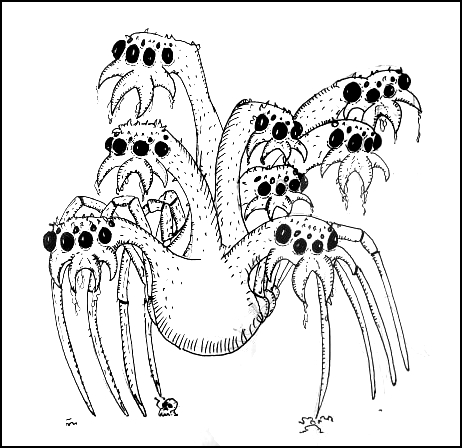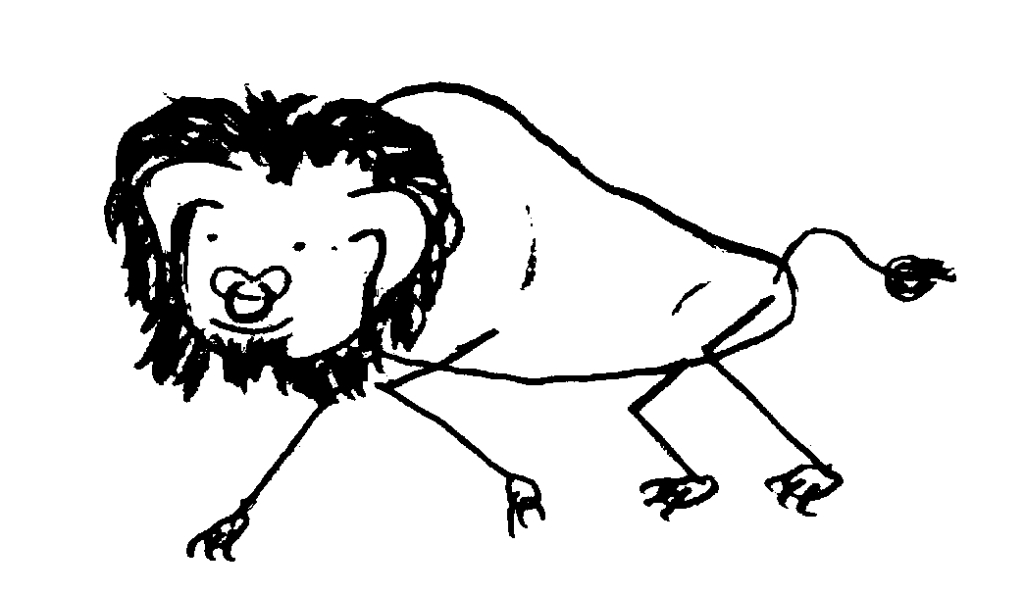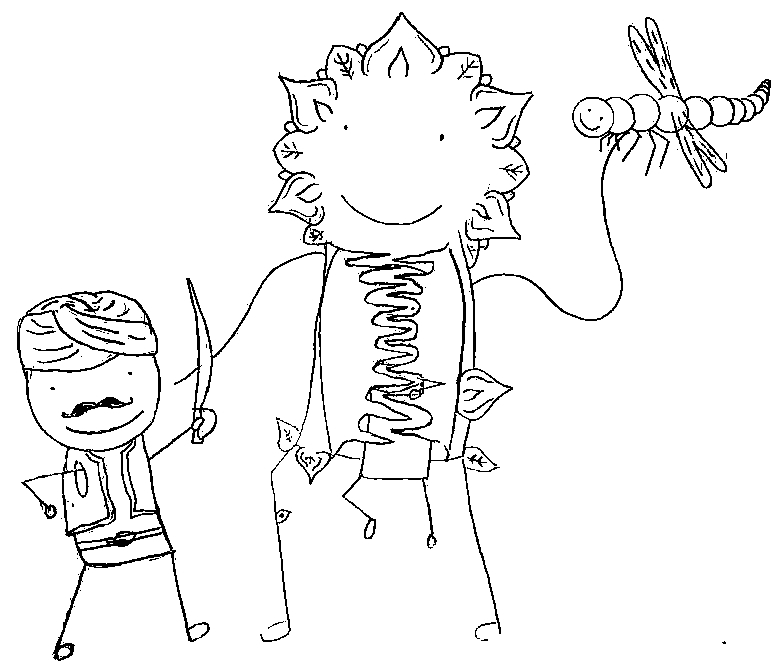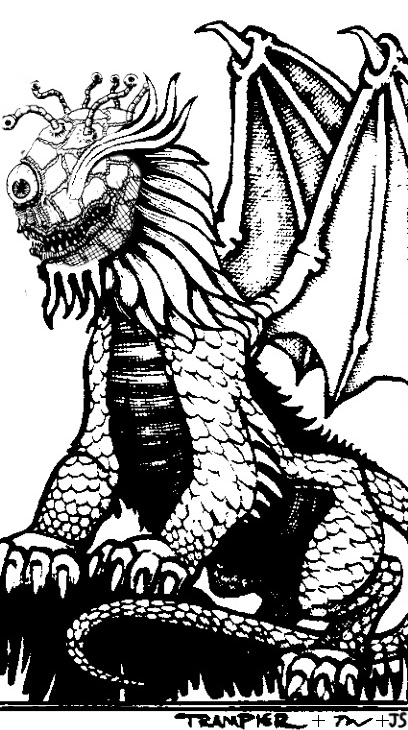I often find myself struggling to create unique monsters to put into my games and frequently just use ‘book monsters.’ I don’t think this is a bad thing as everyone knows what a Purple Worm is. Still, it’s nice when the players have no idea what they’re up against. I shall offer some commentary on making new monsters but the real purpose of this post is as an excuse to post some of my creations so others can use them. The commentary is to give this some form of legitimacy. In creating new monsters, I have roughly seven categories that describe the components of the monster and I find that I overwhelmingly lean towards one of them (the easy one):

Beast + Beast (easy mode): Chimera, Cockatrice, Griffin, Owlbear, Pegasus. Many of these come from myth & legend and is fairly easy to create – take two animals, mash them together. Everyone knows what a horse and a bird look like therefore everyone knows what a pegasus looks like.
Beast + Man: Centaur, Harpy/Siren, Lizardman, Manticore, Medusa, Minotaur, Naga
Beast + Magic: Basilisk, Blink Dog, Dragon, Gorgon (bull type), Hydra, Phoenix
Beast + Big: Giant Scorpion/Spider/Armadillo/Fish/Mantis/Koala/etc, Kraken, Purple Worm, Roc
Man + Magic: Djinn, Elf, Gnome, Shadow, Witch, etc
Object + Magic: Gargoyle, Gelatinous Cube, Golem, Killer Statue, Mimic, Tree-Ent
Truly Unique (hard mode): Beholder, Lurker Above, Mind Flayer, Rust Monster

I find myself leaning away from beast-men and different types of magic humanoids (typically) as we have more than enough of them. If you’re really in a jam, take a forehead alien out of Star Trek and there you go. Giant animals are easy but we’ve more or less run out of animals to make giant.
Magical Beasts is a good place to create new monsters – that’s how we got Pokemon – electricity + rat = Pikachu, oyster + tantric sex magik = Cloyster. You can get creative in this zone while still remaining familiar.
This is also the case with hybrid-beasts, whose tradition stretches far back. Any bozo can stick a scorpion tale on a panther and call it a day.
Inanimate objects is likewise simple and we don’t really need to discuss it further.

The difficult class of monsters is the unique ones with little-to-no precedence and require complete originality and creativity. These are also some of the most memorable monsters we come across. The beholder – a xenophobic ball of floating eyes that launches death rays out of them. The rust monster - a beetle that eats through metal. The lurker above – a killer ceiling. The umber hulk – a psychic beetle-man with insanely-proportioned body parts. The bulette – a shark that swims through the earth hunting down horses.
Many of these were created with a specific goal in mind – a counter to clever players. Is that to say that players aren’t as clever nowadays? Is that to say we’ve ‘solved’ all the various tactics? Even EMDT and Scribes of Sparn, the two Fantasy Adventure Game publishers I respect the most and view as the platonic ideal of what an old-school adventure should be, typically lack these creatures created entirely from the aether (though the Buzzor, a WWF wrestler composed entirely of bees nearly scratches that itch). Is this the true power of NoArtPunk as espoused by Mr OfNothing? That we don’t need the constantly melt our brains trying to come up with un-heard of horrors? That we can get away with the simple?
Let us then look at some ArtPunk classics – Veins of the Earth features a lot of wickedly interesting monsters but still generic – cancer-bears, meth-lions, fossil-vampires, scream-pigs, blindheim-dogs, giant hermit-crab, but we are also given some gems: Igneous Wrath – living heatless flame, and the Mondmilch – living moonlight. Patrick Stewar, the godfather of ArtPunk gave us Fire on the Velvet Horizon – giant slugs, ants, anemone men, horny mushroom spores, an owlbear but an eagle instead of an owl and an ape instead of a bear (ultra cool), and crabs, all very normal, tempered with a moth-man that eats colour, mentally-challenged fog clouds, and the spirit of history. Yes some of these are un-heard of but will they ever occupy the status of a Beholder? Of course not – for one thing half of them don’t actually have rules, and the art is so incomprehensible that no can tell what they are in the first place. Does this not reinforce the NoArtPunk stance?
We did not come here to listen to me vocalize my stream-of-consciousness however. We came here so you could use monsters that I have created.
Arachnohydra BX
AC 5; HD 8 (64hp); Mv 180′ (60′); 8 Bites (1-6); Save as F8; Morale 9; Treasure Type B; Align Neutral.
Arachnohydras are smaller cousins of the traditional hydra, though just as deadly. They always have 8 heads to match their 8 hairy legs. Arachnohydras are able to walk on any surface like a spider, though they do not spin webs. It has one Hit Die for each head, and always has 8 Hit Points per Hit Die. An arachnohydra will attack with all of its heads each round. For every 8 points of damage an arachnohydra takes, one head will no longer attack. An arachnohydra saves as a fighter of a level equal to its number of remaining heads. With 8 eyes on each of its 8 heads, an arachnohydra can never be surprised. Arachnohydras live exclusively underground, often in large caverns where they can hunt for prey. A favoured tactic is to drop from above doorways, preventing exit, and then attacking with its pincer-like mandibles.
Bull-Lion 7VoZ
HD 7; AC 4; Mv 16; 1 Leaping Gore (3-18) or 1 Bite (2-12)
Will signal its appearance by a mighty roar, causing creatures under 4HD to test morale. It can leap from 20-30′ for its gore attack or else it will bite. Less than 20′ and it can’t build up proper speed, more than 30′ is too far. It can only be harmed by blunt weapons; axes, swords, arrows, spears, etc will have no effect.
Ferro-Fluid Golem BX
AC 2; HD 8**; Mv 60′ (20′); 1 slam (1-8) or special); Save as F8; Morale 11; Alignbment Chaotic
Ferro-Fluid Golems are beings of magnetically charged liquid metal that can take the form of humanoids. Any steel weapon used to strike them must make a save vs Spells or be absorbed into its form, at which point the golem will wield these weapons as liquid arms grow out of its torso to hold them. Spells such as heat/chill metal will have their effects doubled against ferro-fluid golems, and spells which have magnetic effects will destabilize the golem, causing it to release all absorbed weapons. Upon its death, all items absorbed must make a save vs Spells or be destroyed.
Lava Bat 7VoZ
HD 5; AC 7; Mv 4/18; Atk 1 bite (2-7) or 2 wings (1-6 ea)
A bat made of lava; it can bite or it can fly over-top of and in-between two combatants, dripping lava from its wings on them.
Oliphant Man 7VoZ
HD 7; AC 4; Mv 12; Atk 1 gore or confusion (2-12)
These anthropomorphic elephants each bear a third eye in the centre of their head of red translucent bone. They may open the lid to reveal this ye, causing any within its gaze to save vs Spells or become confused for 2-7 rounds as they are overwhelmed wit psychic energy.
See-Dragon BX
AC -2; HD 14*** (72hp); Mv 90′ (30′) or 240′ (80′); 2 claws (2-8) and breath weapon or 1 eye breath (7-42); Save as F14; Morale 12; Alignment Chaotic
The See-Dragon possesses five different eye stalks that are each capable of using a different dragon’s breath weapon (white, black, green, blue, red). Each breath cannot be used again until each other breath has been used. Its main breath weapon is a 80’x30′ cone of anti-magic which can be avoided with a Save vs Dragon Breath at -4 to the roll. If affected, it lasts for 1-6 rounds. If the See-Dragon hits with both claws, it is capable of pickup up a character. It cannot use the anti-magic breath and eye-breaths in the same round.
In combat it will either attack with its anti-magic breath and 2 claws, hoping to pick up a character and drop them on the following round, or do strafing runs with its eye-breaths.
Whip Witchet 7VoZ
HD 6; AC 4; Mv 7; Atk 2 vines (immobilize) 1 bite (4-16)
A venus-fly-trap-man. The whip witchet is an un-intelligent predator that can hunt through jungles silently and only fears groups carrying open flames or containing at least 2 amazon warrioresses. Its vine attacks are identical to that of a roper’s.

Dragosaurs BX
Dragosaurs are primal creatures found in lost lands across stormy seas or in the forgotten realms of the hollow earth, where dragons rule supreme under the flaming sphere of the globe’s core. After years of breeding between various dinosaurs and dragons, the signature breath attacks of the dragons have evolved to a more savage state that better suits the dinosaur hybrids that use them.
Ice Shard: this attack targets all creatures within an 80’ x 30’ cone; instead of targets having to roll a Save vs Dragon Breath, the dragosaur must roll an attack against each creature’s AC. Success indicates that they have been pierced by a shard of ice, dealing 3-18 damage.
Lava: this functions similarly to a normal dragon’s fire breath in a 50’ x 40’ cloud shape, but the lava remains on the ground. Each turn a creature spends within the lava, they must roll a Save vs Dragon Breath or take 4-24 damage.
Tar: this attack doesn’t deal any damage, rather it forces all creatures in an 80’ by 30’ cone to make a Save vs Petrification or be stuck in place. They must roll a Save vs Petrification every turn they spend within tar lest they be stuck in place. The dragosaur that uses this breath attack is immune to its effects. The tar is flammable.
Wind: this 100’ x 10’ line forces targets to make a Save vs Dragon Breath or be pushed to the maximum range of the breath attack’s range of effect. If a creature hits a solid object before reaching the maximum range of the breath attack’s range of effect, they will take 1-6 points of damage per 10’ pushed. Example, if a creature is pushed 40’ before striking a wall, they will take 4-24 points of damage.
Type I Dragosaur
AC 1; HD 8*; Mv 60′ (30′)/180′ (60′); Atk 1 tail (2-12) or trample (2-16) or breath weapon; No Appear 1-6; Save as F4; Morale 6; Align Neutral
Type I Dragosaurs are squat winged lizards with rows of stone-like spikes running down their back. Their heads are covered in a hard bony plate that ends in a beak. Their tails resemble spiked clubs and are used to batter down fruit-bearing trees, but are more often used to crush opponents as the dragosaur flies over head. Type I Dragosaurs possess an Ice Shard breath weapon.
Type II Dragosaur
AC 6; HD 13*; Mv 60′ (30′)/180′ (60′); Atk 1 tail (3-24) or trample (5-50) or breath weapon; No Appear 1-4; Save as F6; Morale 7; Align Neutral
Type II Dragosaurs are massive beasts, measuring over 100 feet from the tip of their tail to the head at the end of their long necks. Their wingspan is nearly double this length, having to support such a mammoth beast in flight. While typical docile, if their food source (typically fat, grass-fed aurochs) is threatened, they will become extremely aggressive, causing stampedes amidst gouts of flame arcing from their mouths. Type II Dragosaurs possess a fire breath weapon whose shape is a 60’x5′ line.
Due to their long neck, the fire breath of a Type II Dragosaur may begin the line’s point of origin anywhere within 30’ of the dragosaur’s position, and may be aimed in any direction.
Type III Dragosaur
AC 4; HD 5*; Mv 120′ (40′)/360′ (120′); Atk 1 headbutt (2-8) or trample (2-12) or breath weapon; No Appear 2-12; Save as F2; Morale 6; Align Neutral
The Type III Dragosaur is a smaller breed of dragosaur, often standing at only 6-7 feet on two legs. Their heads are topped with a hard exoskeleton which is crowned by small spikes; in conjunction with their fast flying speed, their hard-domed skulls make for a deadly bullet-like charge. Quirky creatures, their clans are content to collect bones in massive piles as True Dragons do with gold. Type III Dragosaurs possess a Wind breath weapon.
Type IV Dragosaur
AC 2; HD 8*; Mv 90′ (30′)/270′ (90′); Atk 1 tail (2-12) or trample (2-16) or breath weapon; No Appear 1-8; Save as F4; Morale 5; Align Neutral
Early in the evolution of dragosaurs, the Type IV Dragosaur was born; they were smaller than True Dragons and often hunted as food. Because of this, they developed ridges of knife-like plates along their back to protect against aerial predators. They make clumsy fliers and are lazy on foot. Through using their lava breath, they form isolated islands where they can tend to their gardens. Type IV Dragosaurs possess a Lava breath weapon.
Type V Dragosaur
AC 4; HD 10*; Mv 180′ (60′)/360′ (120′); Atk 1 horn (1-8) or trample (4-24) or breath weapon; No Appear 1-2; Save as F5; Morale 9; Align Neutral
Type V Dragosaurs are aggressive, long-horned beasts. Despite their ornery nature, they are the most likely to be domesticated by wild men, who ride them in to battle, mounted behind the flared bone-shield that rises at the back of their heads. A favoured tactic of the Type V Dragosaur is to swoop over its enemies, spewing tar breath before landing and charging the immobilized creatures. Type V Dragosaurs possess a Tar breath weapon.
I want to be shown that people can still make unique monsters that serve a purpose – who’s got some?
Leave a comment